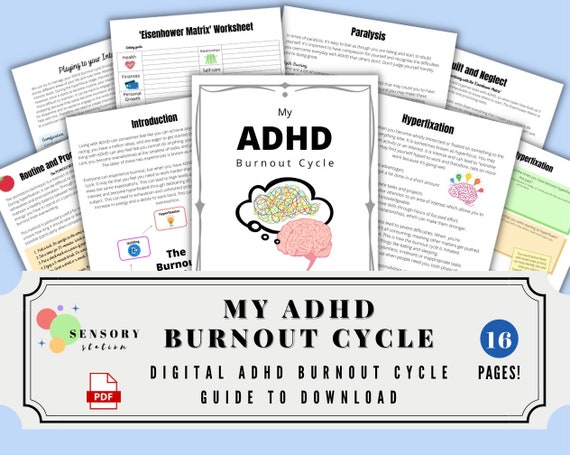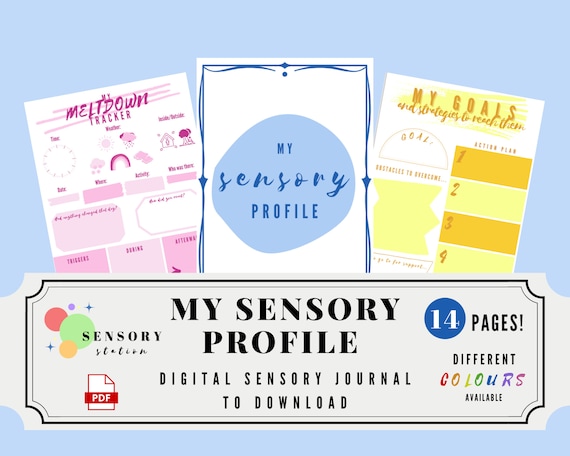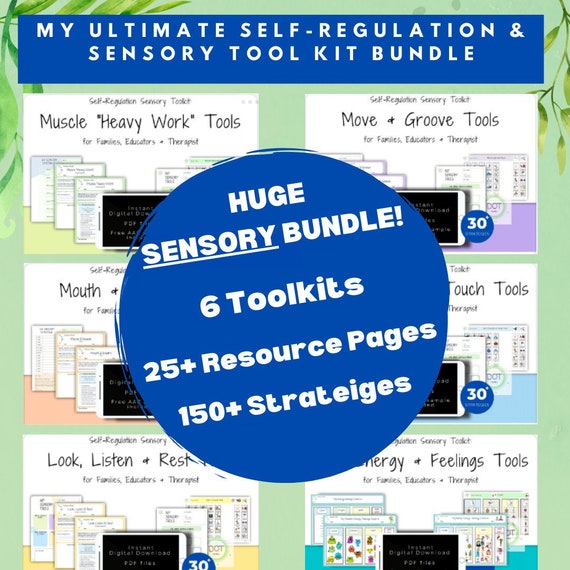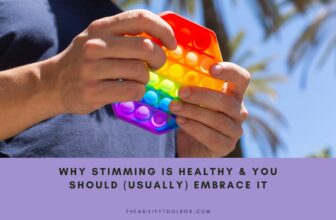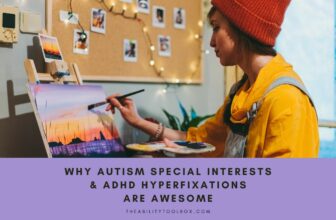If you or a loved one experiences sensory overload, this self-help guide can help you learn the signs and symptoms, address the causes, and develop coping strategies so you can thrive.
Our guide is unique because we are a group of experts who have both lived and professional experience with sensory overload. We are: Olivia Jayne, an autistic person and professional medical writer; Karin Willison, MA Psychology, founder of The Ability Toolbox, who has cerebral palsy and sensory processing disorder; and Charlotte Wilson, MD, a family physician who lives with ADHD and has many pediatric patients who are on the autism spectrum. We aim to provide factual information along with meaningful support and solutions that are neurodiversity-affirming.
What is sensory overload?
Sensory overload happens when your five senses — hearing, sight, touch, taste, and smell — take in too much information for your brain to process. This is caused by too much sensory input in the form of noise, bright lights, strong smells, and other environmental stimuli.
Who experiences sensory overload?
Anyone can experience sensory overload, but it's more common and severe among neurodivergent people and those with certain medical conditions. For example, a jackhammer outside a window could cause sensory overload in a neurotypical person, but someone with sensory processing disorder could find a squeaking office chair in the cubicle next to them just as overwhelming. Neurodivergent people often become overloaded by stimuli that others find harmless or even pleasant.
What conditions are associated with sensory overload?
Sensory overload can affect people with a wide variety of disabilities and health conditions. Let's discuss some conditions you probably know are related, and others you might not associate with difficulties processing sensory information.
Autism, ADHD, and Neurodivergence
Sensory integration dysfunction is a key component of neurodivergent conditions such as autism spectrum disorder, sensory processing disorder, dyspraxia, and attention-deficit hyperactivity disorder (ADHD). People with autism or sensory processing disorder tend to be oversensitive or undersensitive (or both) to stimuli such as loud sounds, bright lights, and touch. Sensory overload is a common cause of the meltdowns autistic people experience.
Developmental Disabilities
Many children and adults with developmental disabilities such as Down syndrome and cerebral palsy have comorbid sensory processing disorders that go untreated because they don't meet enough criteria for an autism diagnosis and medical professionals fail to recognize that you can have one without the other.
Mental Health Conditions, Including Anxiety and PTSD
Sensory overload can trigger or exacerbate panic attacks in people with panic disorder, anxiety, and post traumatic stress disorder (PTSD). Specific sounds, sights, and smells can also trigger PTSD flashbacks and panic attacks.
Acute or Chronic Pain
Pain is a common trigger for sensory overload, because such intense sensory input limits the brain's ability to cope with further stimuli. Chronic fatigue can also trigger sensory overload because a person’s body is too exhausted to process additional sensory input. Therefore, sensory overload is common among people with multiple sclerosis, fibromyalgia, cerebral palsy, and other physical disabilities that cause chronic pain and fatigue.
What are the signs and symptoms of sensory overload?
Sensory Overload Symptoms in Adults
Symptoms of sensory overload vary depending on the individual and the type of stimuli, but may include feeling overwhelmed, disoriented, irritable, and experiencing physical discomfort such as nausea or headaches. People experiencing sensory overload may be unable to focus on anything else and feel a strong need for the environment to be quiet, dark, and free from other stimuli.
Signs of Sensory Overload in Children
Sensory overload in children can be easily missed because kids often can't communicate what they are feeling. Children experiencing sensory overload may become withdrawn, have difficulty focusing, act out, and have meltdowns that are wrongfully labeled as temper tantrums. ADHD sensory overload often manifests as being disruptive in the classroom.
It's also common for kids to go through the school day without apparent struggles and then have a massive meltdown when they get home. If this happens, they are NOT actually coping well at school; it's a sign they need far more support.
Recognizing a Sensory Crisis
If sensory overload is not quickly addressed, it can become a crisis. Someone in a sensory crisis may be unable to control their own behavior and become aggressive or have a meltdown or panic attack. They could also experience a shutdown and be unable to communicate or function.
What does experiencing sensory overload feel like?
Sensory overload is such a complex and unique experience, it can be difficult to describe in words. Even the tiniest sound can become excruciatingly painful to the ears. A soft touch can feel like a slap. Anything and everything becomes too much to handle. Your brain feels trapped. Extreme irritability can make you lash out or withdraw and sometimes literally curl up and cry. Sensory overload can cause some autistic people and others to engage in involuntary self-injury behaviors because their minds hurt so much. If someone you love experiences sensory overload, ask them to describe it so you can support them better the next time it happens.
Common Sensory Overload Triggers
Almost any sound, sight, touch, taste, or smell can lead to sensory overload for someone, but here are some common irritants:
- Loud noises: Construction, loud music, car brakes screeching, children screaming
- Unpleasant or repetitive sounds: People chewing, nails on a chalkboard, knuckle popping, tapping. This is also known as misophonia.
- Harsh visual stimuli: Flashing lights, fluorescent bulbs, bright or intense lighting
- Trying to focus in a high-stimuli environment: Listening to or watching something while there is background noise or visual distractions
- Negative tactile sensations: Chronic pain, itchy tags or clothing, uncomfortable chairs, sudden physical contact. For people with tactile defensiveness, “ordinary” activities such as walking barefoot in the grass can be emotionally and physically painful.
- Food: Items with uneven consistency, strong-smelling foods, slimy foods, sometimes spicy foods
- Strong scents: Bad smells, perfumes, chemicals, bleach, vinegar
- Cumulative stress: Often, a single unpleasant stimulus will not trigger sensory overload or a meltdown, but many small triggers add up.
How to Prevent and Manage Sensory Overload in Adults
Managing sensory overload can be challenging, but there are strategies that can help:
Identify which sounds, sights, smells, and/or movements cause a sensory overload reaction for you.
Sensory processing issues are unique to each person; what distresses you a lot may barely bother someone else. To manage your own sensory system, start by identifying the things that cause the highest stress response for you. Prioritize those that affect you in everyday life and that are more difficult to avoid. A trigger like fireworks may be severe, but it only becomes an issue a few times per year, so while it’s important to be aware of it, it may not be something you need to worry about on a daily basis.
Prevent sensory overload whenever possible.
Sensory overload is like a freight train — once it gets going, it's hard to stop. Once you have identified your primary everyday triggers, you can formulate a plan to prevent sensory overload. This will be much easier than trying to deal with it after the fact when it’s difficult to stay calm and rational.
Find the right sensory overload coping tools for your needs.
It would be nice if the world was quiet, calm, and peaceful, but that’s not the reality we live in. Therefore, if you experience sensory overload, you’ll need to develop a set of personalized coping tools to get you through life. This is also known as practicing good sensory hygiene. These sensory overload coping tools will vary for each person, but some that benefit many people include:
- Mindfulness and meditation exercises
- Physical activity such as walking
- Spend time in nature or in a quiet, contemplative environment such as a church or library
- Wear high-quality earplugs or noise-cancelling headphones while in loud, busy, and/or distracting environments
- Use sensory toys to relieve anxiety and improve focus
- Use a weighted blanket, lap pad, and/or stuffed animal at home, school, or work
- Talk to loved ones about your sensory issues and ask them to be understanding and accommodate your needs
- Utilize self-help worksheets to develop a personalized sensory diet, track your symptoms, and figure out which coping tools work best for you
Develop a sensory overload emergency plan.
Even if you have developed good sensory hygiene practices, you may still encounter unexpected situations that trigger sensory overload. Therefore, you should develop an emergency plan to help yourself and help others assist you if you get overwhelmed. Here are some tips for developing a crisis plan:
- Write a brief explanation of your disability and needs and keep it with you at all times. It’s better to have a printed copy, but if that’s not feasible, it can be on your phone. If you experience meltdowns or shutdowns and have difficulty communicating, this information can help others help you and avoid unwanted complications such as the police being called.
- Carry a few coping items such as fidget toys with you so you have them available at all times to avert or minimize sensory overload. Wearing fidget jewelry or chewelry is a great way to ensure you can stim anywhere and anytime. Be sure to mention them in your emergency instructions if they would assist you in a crisis.
- Have designated safe spaces to go in each location where you spend time regularly. For example, if there is a conference room at your office or university building that rarely gets used, you could plan to go there if you feel overwhelmed.
- If possible, set up an emergency contact you or someone assisting you can call who will be supportive in a crisis. If there’s someone at your workplace or school that you trust, make sure others around you know that they can be called upon if you become overwhelmed.
Set boundaries for yourself.
It’s OK to say no to doing things and being in places that cause sensory misery for you. It’s also OK to push yourself or work on improving your coping skills so that you can do things you really want to do. It’s up to you and only you to decide where to draw the line. Don't let other people pressure you, or impose pressure on yourself to please your family and friends. This can be hard, but if you develop your self-advocacy skills, it gets easier, and your life can improve more than you might imagine.
Stand up for your rights and your comfort.
Sensory processing disorder is a disability and you have the right to reasonable accommodations at school and work. These may include a quiet workspace, being allowed to wear earplugs or noise cancelling headphones, and more. It can be difficult to get people to understand invisible disabilities, but you shouldn’t be held back in life because of sensory overload.
Consider counseling or therapy to treat sensory overload.
Both children and adults can benefit from sensory integration therapy provided by an occupational therapist. Cognitive behavioral therapy provided by a psychologist, counselor, or licensed social worker can help you gradually desensitize to triggering sounds and situations. It’s important to find the right therapist who will encourage and support you but not push you beyond your limits.
Need more ideas? Check out our articles on sensory processing disorder coping tips and tips for coping with misophonia and misokinesia.
How to Support a Child Who Experiences Sensory Overload
If you're the parent of a child who is experiencing sensory overload, it can be overwhelming for both of you. Here are some tips for helping them cope and thrive:
Learn your child's sensory overload symptoms, and be mindful of potential triggers yet to be discovered.
Learn which sensory inputs affect your child negatively. Pay close attention to their behavior, as they may not be able to understand or explain their feelings. Look for early sensory overload signs so you can pull them out of a situation before they become overwhelmed. Bear in mind that children's brains are still developing, so their sensory perceptual experiences will change as they grow.
Create a sensory-friendly space in your home.
It's important that your child have positive sensory experiences in a safe space. Your child needs to escape from a world filled with too much sensory information. Create a sensory room where they can get the soothing sensory inputs they need, such as swinging, rocking, and fidgeting. Sensory swings are a helpful solution for many kids and adults who need a safe space to calm down or process anxious energy.
Enroll your child in sensory integration therapy, occupational therapy and/or counseling.
Early intervention, school-based services, and after-school therapy programs can help your child learn to cope with stressful sensory stimuli. Occupational therapists can teach your child self-regulation skills such as noticing their body and emotional cues and how to respond appropriately. These therapists can also help you learn to spot sensory overload signs in your child, and develop a sensory diet to encourage their skill development at home.
Ensure your child's IEP is followed and that they are in an integrated school classroom.
Make sure your child has an IEP that requires accommodations such as a quiet escape space, earplugs or ear defenders, extra time to complete tests, and other services recommended by their doctor or occupational therapist. But don't let them be stuck in a self-contained classroom! Children who experience sensory overload shouldn't be segregated based on their disabilities. Inclusion is key for them to succeed in adult life.
Be patient and understanding.
Your child is not bad or naughty if they have meltdowns — they're overwhelmed. Don't punish them when the stresses of the school day lead to sensory overload at home. If you are neurotypical, remember that your child's sensory world is very different from yours. You may never fully understand how it feels to be them, but you can still support them. Allow them time and space, but be available if they need you — and they will.
Practice sensory self-care for yourself, too.
Encourage healthy sensory practices such as deep breathing, mindfulness activities, and physical exercise by doing them along with your child. Model self-care by practicing it yourself, so you can be at your best, too.
Sensory processing disorder can’t be cured, but it can be managed so you can enjoy your life without constant discomfort. Remember, you are not alone, and people with this underdiagnosed condition are finally starting to get the recognition and understanding we desperately need and deserve.
How do you cope with sensory overload?
Share your experiences with our safe and supportive neurodiversity community in the comments.
More Autism & Neurodiversity Resources in The Ability Toolbox
- Calm Strips: A Complete Guide to Fidget Stickers for Anxiety, Autism, & ADHD
- The Ultimate Executive Dysfunction Self-Help Guide: Coping Skills to Help You Thrive
- All About Autism Masking and Camouflaging
- Sensory Lights for Autism and ADHD: A Guide
- Awesome Autism Books Written by Actually Autistic Authors
Hey I'm Olivia and I'm a proud Autistic woman. My special interests are cats, stim toys, and electronic music! I love to write and help other Autistic adults find ways to enjoy life in this LOUD world!
Founder and Editor-in-Chief of The Ability Toolbox. I received my BA in English from Stanford University and MA in Clinical Psychology from Antioch University Los Angeles, and have worked in entertainment and health media for over 20 years. I also blog about traveling with a disability. As a wheelchair user with cerebral palsy, I am deeply committed to amplifying the voices of the disability community through writing and advocacy.
Dr. Wilson graduated from Rosalind Franklin University of Medicine and Science and completed her residency in Internal Medicine at Advocate Good Shepherd Hospital in Barrington, IL. Dr. Wilson specializes in providing culturally competent and trauma-informed care to patients with physical disabilities. In addition to her private practice, she works as a science communicator, teaching health literacy to middle school and high school students in her local school district.


